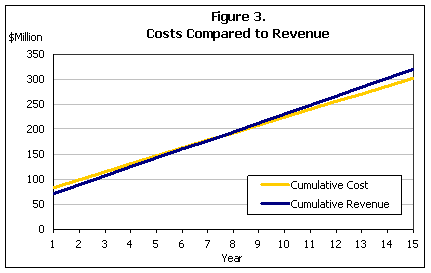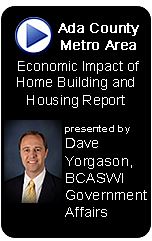The Metro Area Impact of Home Building in Ada County, Idaho
By: The National Association of Home Builders
July 2007 Executive Summary
The Evidence Is In: Housing Pays for Itself!
The Building Contractors Association of Southwestern Idaho recently commissioned a housing impact study for the Boise-Nampa, ID MSA that shows housing has a huge economic impact on the community.
The NAHB study compares the benefits to the costs of all new home construction in Ada County in 2006 on all political jurisdictions in the Boise-Nampa, ID MSA. The report found that the economic impact of home building in Ada County is not only very large, but that single family construction pays for itself within eight years because the ongoing economic benefits accumulate faster than the ongoing costs.
This is the case because the annual surplus, or yearly net tax to local governments, accumulates fast enough so that, even if local government undertakes all capital investment before the homes are built, the surpluses can be used to pay off the debt entirely by the end of the eighth year.
Benefits to the Boise-Nampa, ID MSA:
The one-year local economic benefits of building 4,724 single family homes include:
- $702 million in local income
- $63 million in taxes and other revenue for local governments
- 16,078 local jobs
These are one-year impacts that include both the direct and indirect impact of the construction activity itself, and the impact of local residents earning money from the construction activity and spending part of it within the local economy.
The same 4,724 homes also generate additional, annually recurring local economic benefits including:
- $137 million in local income
- $18 million in taxes and other revenue for local governments
- 3,430 local jobs.
These are ongoing, annual benefits resulting from the new homes being occupied, and the occupants paying taxes and participating in the local economy year after year.
These numbers were reached assuming that a new single-family home built in Ada County:
- Costs $260,000
- Is built on a lot costing an average of $35,000 (purchase price the developer or builder pays for raw land)
- Requires the builder and developer to pay $9,000 in permit and special fees
- Incur an average annual property tax payment of $2,048.
Costs to Local Government
 The Census of Governments provides information on the amount local governments in the Boise-Nampa, ID MSA spend on various government functions. The results for each new single family house built in Ada County are shown in Figure 1.
The Census of Governments provides information on the amount local governments in the Boise-Nampa, ID MSA spend on various government functions. The results for each new single family house built in Ada County are shown in Figure 1.
Not surprisingly, local governments tend to spend more on education than any other single item. However, there are several factors in most parts of the country that tend to reduce education costs per housing unit.
A major one is simply the number of children present in the units. According to the American Housing Survey, there is only a little over one school-aged child for every two households in the U.S.; so education costs per housing unit are lower than costs per pupil, simply because there is, on average, less than one pupil in each household.
In addition to current expenses, providing services to residents requires local governments to undertake capital investment for schools, other buildings, equipment and roads. The NAHB study estimates the size of these investments from a traditional economic model, where costs are a function of labor and capital. The results for each new single family home built in Ada County are shown in Figure 2.
Comparing Costs to Revenues
To summarize the results, in the first year, building 4,724 single family homes results in
- An estimated $71.8 million in tax and other revenue for local governments.
- $7.7 million in current expenditures by local government to provide public services to the net new households at current levels.
- $73.6 million in capital investment for new structures and equipment undertaken by local governments.
In each year after the first, the same 4,724 single-family homes create $17.7 million in tax and other revenue for local governments and $15.3 million in local government expenditures needed to continue providing services at current levels. The difference is a $2.4 million “operating surplus” that can be used to service or pay down the debt.
It is important to point out that the operating surplus is the subsidy from new construction to existing construction. Without this large annual subsidy, property taxes would either be higher than they are, public services would be of lower quality than they are, or some combination of both.
 After 15 years, the 4,724 single family homes will generate a cumulative $319.4 million in revenue compared to only $302 million in costs, including annual current expenses, capital investment, and interest on debt (Figure 3).
After 15 years, the 4,724 single family homes will generate a cumulative $319.4 million in revenue compared to only $302 million in costs, including annual current expenses, capital investment, and interest on debt (Figure 3).
A complete report with more detail, and a technical explanation of the cost model is available at NAHB website. Contact Frankie Hickman at (208)377-3550 or fhickman@heritagewifi.com to get a copy.
